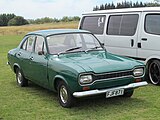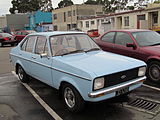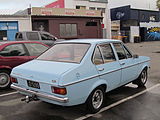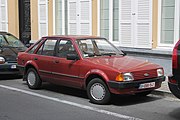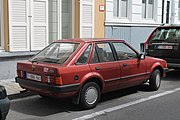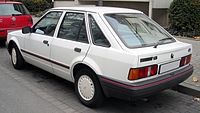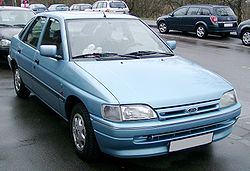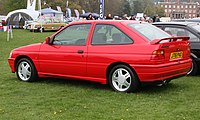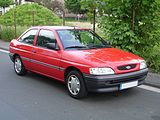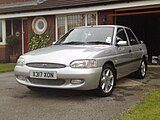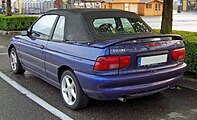Ford Escort
| Ford Escort | |
|---|---|
| Production period: | 1967-2000 |
| Class : | Lower middle class , compact class |
| Body versions : | Sedan , hatchback , station wagon , van , Cabriolet |
| Previous model: | Ford Anglia |
| Successor: | Ford Focus |
Ford Escort is the name of several compact or lower middle class passenger car models produced in Europe from autumn 1967 to summer 2000 by the automobile manufacturer Ford .
After the transit, the escort was the second joint project between the German and British Ford branches.
The independent notchback model Ford Orion was produced on the platform of the third generation of the Escort from the summer of 1983 to the end of 1993 . Measured by the number of registrations , the Escort was one of the best-selling cars in Europe.
From spring 1981 to the beginning of 2003 there was also an American escort , which was initially related to the European model, but was later based on the platform of the Mazda 323 .
The successor in Europe was the Ford Focus in autumn 1998 .
In the summer of 2014, the model name "Escort" was revived for a new generation of models for the Chinese market . It is the first Ford brand vehicle developed exclusively for China.
The model name Escort was already used in the 1950s for a simply equipped version of the Ford Squire .
Escort '68 (1967–1974)
| 1st generation | |
|---|---|
|
Ford Escort (1967–1974) |
|
| Production period: | 11 / 1967-10 / 1974 |
| Body versions : | Limousine , station wagon |
| Engines: |
Petrol engines : 1.1–2.0 liters (29–74 kW) |
| Length: | 3978-4070 mm |
| Width: | 1565-1572 mm |
| Height: | 1391-1425 mm |
| Wheelbase : | 2400 mm |
| Empty weight : | 825-900 kg |
Model history
The first independent model with the name Escort developed by the British Ford works was produced in Halewood , UK, from November 17, 1967 . On the British market it replaced the technically similar Anglia, and in Germany it rounded off the range.
At the beginning of January 1968, the Escort with its characteristic radiator grille (also known as the "dog bone") was presented to the press in Morocco . A few days later, the official presentation took place on the occasion of the Brussels Motor Show. The sales figures exceeded the manufacturer's optimistic expectations by 30% after just two months. Less than five months after the show was launched on June 4, 1968 already the 100,000th Escort in Halewood from the band . In Germany, the first car left the factory in Saarlouis on January 16, 1970 . The cars sold in Germany in 1968 and 1969 were produced in the British plant.
Ford inherited the technology from the previous Ford Anglia model . The escort was particularly popular in Great Britain, but in Germany it fell short of the expected numbers. The Beetle from the market leader Volkswagen was technically outdated, but better processed, and there were also established and in some areas superior alternatives with the Opel Kadett B and French and Italian import cars.
In mid-1973 the RS2000 was added as a top model in West Germany . It was recognizable by the eye-catching two-tone paintwork and the widened wheel arches at the front. With 74 kW (100 PS), the light escort achieved many successes in motorsport. However, the British Escort TwinCam and its successor, the RS1600 with a Cosworth BDA -16V engine, were far more successful in international motor sport . With this engine, the RS1600 was able to win the European Rallycross Championship in 1973 , the Finland round of the World Rally Championship and several rounds of the German Racing Championship .
Motorsport
The Escort was originally designed without considering the requirements of motorsport. However, Ford Motorsport organized an early copy and over a weekend conducted fit tests of the Lotus Cortina's mechanics. The front axle of this competition vehicle was easy to mount, as was the rear axle with only minimal changes. However, due to its protruding cylinder head with cast-on intake ducts and the voluminous carburetor and air filter system, the Lotus engine did not fit under the bonnet until the front end of the engine was moved a few centimeters to the left (in the direction of travel). The engine was not sitting straight in the engine compartment, but turned a little to the left. The battery had to be moved to the trunk to make room for the exhaust.
In order to accommodate the much larger transmission of the Cortina, the bulkhead and transmission tunnel were modified accordingly with a two-kilo hammer.
The changes to the body were limited to slightly wider rear fenders to cover the wide rear axle, flared front wheel arches, reinforcement plates on the strut mountings and the modified transmission tunnel. Such bodies ran in production as "Type 49" and had chassis numbers that begin with "49".
The resulting model was initially produced as an Escort Twin Cam in regular production in Halewood and completed in a remote corner of the factory. Around 1,100 vehicles were built there. However, when the management found that there was a failure of one and a half normal Escort for every 49er body, production in Halewood was stopped. Further examples were made at Ford Motorsport in Boreham.
The Lotus engine gradually proved to be no longer sufficiently powerful and also not particularly reliable in sports use, and it was also complex and expensive to maintain. So Cosworth was commissioned to design a new four-valve cylinder head for the existing block. The resulting BDA engine replaced the Lotus four-cylinder in the otherwise unchanged vehicle, which was then marketed as the Escort RS 1600. The BDA engine was also installed at an angle in the engine compartment, although this would no longer have been necessary due to its considerably slimmer dimensions. Taking advantage of all manufacturing and repair tolerances, the BDA had 1601 cm³ and was therefore allowed to be increased up to two liters in the sport. Several hundred copies of the RS1600 were made in Boreham. With the existing gray cast iron block, however, no more than 1835 cm³ could be achieved. The external tuner Brian Hart had designed an aluminum engine block on his own without the knowledge of Ford, which could replace the cast iron block and offer the possibility of realizing a two-liter displacement.
The sports specimens had a displacement of two liters and rear axles with four trailing arms as Watt linkage, a Panhard rod and coil springs. With such vehicles, the Ford team with drivers such as Roger Clark, Timo Makinen and Hannu Mikkola was able to achieve numerous successes in rallying.
Ford made all developments of the works team generally available via its RS dealer network, which is well-developed, especially in Great Britain, as soon as they proved to be sensible and stable. In this way, every team, provided they had sufficient financial strength, was able to prepare vehicles to factory standards. As a result, Ford was often defeated by private teams in competitions, but this was not unwelcome for marketing reasons. This made Escort RS very popular competition vehicles in Great Britain. There was the phrase that every weekend somewhere in Great Britain there is some event that is won with an escort.
body
The Escort was designed by its developers as a notchback sedan with a self-supporting all-steel body. First the two-door sedan appeared, which was followed in April 1969 by a three-door station wagon (called "tournament" at Ford). From September 1969 Ford also offered a four-door sedan and a panel van.
The trunk of the sedan held 270 liters, the station wagon had a load volume of 1.53 m³.
The vehicles basically had round main headlights, only the upscale “Super” equipment was delivered with rectangular headlights.
landing gear
The chassis of the Escort is kept simple. The front wheels are suspended from MacPherson struts and wishbones - the front wheels on the first English Escort series were guided lengthways by push rods. An anti-roll bar was used for this on vehicles made in Germany . This wheel guidance was later also adopted for the English models. The steering was new, with pinion and rack.
The rigid rear axle was initially guided exclusively on semi-elliptical leaf springs and provided with inclined shock absorbers . In the course of the facelift, the rear axle later received additional trailing arms .
Brakes
When the model was launched, the 1100 models were equipped with drum brakes on all four wheels. The 1300s had disc brakes at the front , drum brakes on the rear wheels and a brake booster .
Engines
The 1959 Ford Anglia imported four-cylinder - Kent engines were developed for the escort. They received new cylinder heads - intake and exhaust manifolds faced each other - with Heron combustion chambers , which are designed as a recess in the piston crown under the flat cylinder head. All engines have the same bore of 80.98 mm. The different displacements are achieved by different strokes .
Power transmission
All Escort I were equipped with a fully synchronized four-speed gearbox as standard. A three-speed Borg-Warner 35 automatic transmission was available for an initial surcharge of 799.20 DM .
A cardan shaft transferred the power to the rear axle, on the 1100 models of the first series it was one-piece, the models from 1300 cm³ had a two-piece cardan shaft.
Escort '75 (1974-1980)
| 2nd generation | |
|---|---|
|
Ford Escort (1974-1977) |
|
| Production period: | 11 / 1974-07 / 1980 |
| Body versions : | Limousine , station wagon |
| Engines: |
Petrol engines : 1.1–2.0 liters (32–81 kW) |
| Length: | 3978-4140 mm |
| Width: | 1564-1596 mm |
| Height: | 1398-1414 mm |
| Wheelbase : | 2405 mm |
| Empty weight : | 880-975 kg |
Model history
For the second Escort generation developed under the code name "Brenda", Ford took over the platform and technology of the predecessor with notchback and rear-wheel drive. The body was smoothed, the grill was rectangular and the lower edge of the window was straight, with the "Tournament" station wagon, the " Coke Bottle Line " of the old model remained; only the front section has been adjusted.
The Escort '75 also had rear-wheel drive, like the main competitor Opel Kadett C , which was produced until 1979 , but with axle-guiding leaf springs. In 1974 in continental Europe these were almost only found in Japanese imported cars.
Towards the end of the 1970s, the Escort did not always receive positive reviews from the German motor press, especially since the basic concept with rear-wheel drive was getting on in years. In the UK, however, it sold well.
Facelift
As early as August 1975 there were the first small technical changes, such as a better fitting exhaust system, a reinforced alternator holder and an electromagnetic shut-off valve as a retrofit (so-called anti-diesel kit) to prevent the engine from running after it was switched off ("refilling"). The valve was soon taken over into series production from the factory. These small changes in details resulted from initial observations by customers, workshops and tests by specialist magazines.
In August 1977, the German version of the Escort received its first recognizable facelift, with the front grille, trunk lid and steering wheel hub cover being provided with the oval Ford logo instead of the previous lettering made of individual letters (previously Escort lettering in cursive on the steering wheel). In addition, the details of the equipment as well as the color palette and the cover fabrics have been changed.
From the spring of 1979, with the exception of the "Sport" and RS 2000 models, all Ford Escort models from the basic version were fitted with the rectangular headlights of the previous GL and Ghia variants. The wheel offset has been changed to widen the track. The rear axle got single leaf springs instead of the layered three-layer leaf springs in front of it and the engine output was given an average of two horsepower more, which was justified with the installation of an electrically driven fan instead of a V-belt.
Equipment lines
The Escort was offered in Germany as the basic version Escort, L , GL , Ghia , Sport and RS2000 , the volume model was the Escort L. In addition to the model variants, numerous "extras" could be ordered. In general, however, Ford advertised not to offer “a naked car” (original advertising text), as there was a heated rear window, front disc brakes or the electric windscreen washer system as standard from the basic model, which was ordered separately in comparable models from other manufacturers (VW Golf, Opel Kadett ...) and had to be paid for. But there was no sunroof.
The top model in Germany was the RS2000 (in Great Britain it was the RS1800 with a BDA engine). The 2.0-liter OHC engine with 74 kW (100 PS), already known from the Escort '68, received another 10 PS more, which was achieved through a modified exhaust manifold. The new engine gave the escort higher performance. The distinguishing feature of the RS2000 was the bevelled plastic front made of polyurethane with double headlights.
Special models
In 1976 the special model "Cologne" was launched, which was difficult to see from the outside, as the car primarily had an improved interior (seats from the Escort Ghia, but door panels from the Escort L), but on the outside looked like an Escort GL.
Also in 1976 Ford launched 400 units of the “RS2000 Spezial” as “Group 1b” homologation versions for rallying / racing. This model variant was provided with flared fenders made of GRP and deeply dished 7.5Jx13 wheels in the typical RS cross design with 235/60x13 tires. Other features were a middle "Cologne" axle with a slightly narrower track and 75% limited-slip differential , which was also used in the Capri , a triple-bearing stabilizer on the front axle and a Bilstein gas pressure shock absorber . The plastic tank held 60 liters in order to meet the relatively high fuel consumption during a rally. The 2.0-liter OHC engine received a different camshaft , larger valves, two double carburetors of the 44 IDF type from the Italian manufacturer Weber and a larger downpipe exhaust manifold, which achieved an output of 97 kW (132 hp).
The 1977 model "Team", which shared similar details with the special model "Team" of the Ford Taunus (color scheme, trim, additional headlights) was easier to recognize and was based on the Escort Sport in appearance and chassis, but was also at 40 kW (54 PS).
In 1978 there was a “Happy Weekend” model with an upgraded interior and two-tone side stripes. These side stripes can also be found on models of foreign versions.
Motorsport
With the Escort RS1800 were Björn Waldegård 1979, Ari Vatanen 1981 world rally champion , with only Waldegård started for the factory team, Vatanen's vehicle was used by a private team. Ford was also able to secure the brand title in 1979. The vehicle was equipped as opposed to the production vehicle from the UK with a BDA engine with 2 liters, the 180 kW (about 245 hp) at 7,000 min -1 made.
The Escort II was also used in motorsport after its appearance. Ford used the trick of not registering the II as a new vehicle, but only as a modified body of the existing model. Therefore, Ford did not need to build a new homologation series. Due to the similarity of the construction of the two Escort generations, all motorsport parts of the old vehicle could be taken over without changes, because the new body was very similar to the old one. It was also modified with a cleverly used hammer on the transmission tunnel, but the battery could remain in the engine compartment. The engine was still mounted crooked. Only in Great Britain was there a version called the RS1800 and Cosworth engine. A total of 109 copies were made of this type. There are now far more replicas than originals. Since Ford feared a tightening of the motorsport regulations with fewer modification options, they created a model that only existed on paper and was never produced, the Escort RS. It was an RS1800 with all the parts used in sports such as the coil-sprung rear axle with trailing arms and Panhard rod, rear disc brakes, ZF five-speed gearbox and engine modifications. Although Ford had never manufactured such a vehicle, the many parts kits sold could prove that a sufficiently large number of such vehicles had been built and received the sports license for this fictitious vehicle. All other motorsport successes were then achieved either with profoundly modified RS1800 or with RS in series production, depending on the point of view.
At that time, the two-liter BDG engines had an output of 206 kW (280 hp) for circuit use, 250 hp for most rallies and up to 270 for real asphalt rallies such as the Corsica, San Remo or Monte Carlo rallies with injection systems and dry sump lubrication PS. In terms of performance, the Escort were clearly superior to the main competitor Fiat 131 Rally Abarth, which usually did not generate more than 220 hp and did not have more than 250 hp even in asphalt competitions. The Fiat was able to compensate for this major performance deficit with its superior chassis with independent rear suspension on asphalt. Since Ford was not willing to finance changes to the Escort, Ford often limited itself to deployments in muddy and snowy rallies such as the 1000 Lakes in Finland, the Sweden Rally and, above all, the RAC in Great Britain, where the Escort is used could exploit its performance advantage. Nevertheless, Ford was only able to win the championship in 1979 and then officially withdrew the escort from motorsport. Private teams were still very successful with the escort for a long time.
Escort '81 (1980–1986)
| 3rd generation | |
|---|---|
|
Ford Escort five-door (1980–1986) |
|
| Production period: | 07 / 1980-12 / 1985 |
| Body versions : | Hatchback , station wagon , van , Cabriolet |
| Engines: |
Otto engines : 1.1–1.6 liters (37–97 kW) Diesel engine : 1.6 liters (40 kW) |
| Length: | 3970-4052 mm |
| Width: | 1640 mm |
| Height: | 1369-1400 mm |
| Wheelbase : | 2395 mm |
| Empty weight : | 765-920 kg |
Model history
As early as the winter of 1975, around two years after the first oil crisis , development work began on the successor to the model built since the end of 1967, which continued to run as the second generation from the end of 1974 with only minor modifications. The aim of the developers was to become competitive with the very successful VW Golf.
The third generation of escorts (code name Erika ), which was available in Germany from September 26, 1980 at prices between DM 11,000 and DM 17,000 , marked a radical departure from the two previous model series.
The Escort '81 was the first Escort with a hatchback (called Aeroheck ), a transverse engine with front-wheel drive and rear independent suspension on trapezoidal wishbones and shock absorber struts. The CVH engines specially developed for this model were also new .
For sale beginning of the Car of the Year in 1981 along with five different trim levels were five engines to choose from:
- 1.1 liter CVH engine with 55 or 59 hp
- 1.3 liter CVH engine with 69 hp
- 1.6 liter CVH engine with 79 or 96 hp
The new Ford Escort was particularly popular in Great Britain and was the best-selling car in 1982.
If, in addition to the pure development costs for the vehicle, the investments in the production facilities are taken into account, the total costs for the development of the third series at that time amounted to around 2.5 billion DM.
At the beginning of 1981 the model series was supplemented by a panel van, called Express . In addition, there were extensive changes to the chassis and engine range of the Escort at the beginning of the '83 model year (from August 1982). The chassis, which was criticized as uncomfortable, was improved and the 1.1-liter CVH engine was replaced by the older, but proven 1.1-liter Kent engine from the Ford Fiesta due to unsatisfactory consumption values .
In the spring of 1983, the tournament called station wagon was also offered as a five-door. With a notchback it was sold as Ford Orion from mid-1983 and was originally positioned as a separate model series similar to the VW Golf / Jetta team. In addition , the convertible manufactured by Karmann in the Rheine plant was available from the summer of the same year .
Shortly before the end of production in 1986, the first escort with a regulated catalytic converter was presented. For this purpose, the 1.6-liter engine of the XR3i was equipped with an electronically controlled injection system (Bosch KE-Jetronic ) and the compression was reduced from 9.5: 1 to 8.5: 1. The engine, designed for regular gasoline, developed 66 kW (90 hp) and complied with the Euro 1 emissions standard . Due to the short construction time and the then still low demand for low-emission vehicles, very few copies of the engine were sold. In the successor model, however, this engine was very popular and, in addition to the engine without a catalytic converter with 77 kW (105 hp), was also offered in the XR3i models.
A sister model of the Escort '81 was offered in the USA from spring 1981 to summer 1990 , to be found under Ford Escort (USA) .
Equipment lines
- Escort L
- Escort GL
- Escort Ghia
- The XR3 was a decidedly sporty version of the Escort with sports seats, light alloy wheels, sports steering wheel and a revised chassis. The 1.6-liter engine CVH made thanks to a Weber - carburetor , a modified manifold including exhaust system and another camshaft 71 kW (96 hp). At first the vehicle was only equipped with a 4-speed gearbox, later versions had five gears as standard. The XR3 was available as a three-door sedan and a convertible.
- The XR3i was based on the XR3, which, like the special model RS1600i, was equipped with the K-Jetronic , an injection system from Bosch, in October 1982 . The engine, which was otherwise only equipped with a different camshaft, now developed 77 kW (105 hp). Like the XR3 , the XR3i was also offered as a convertible.
Special models
- The Escort laser was sold from 1983 to 1985 and was based on the Escort L . The standard equipment of the laser included a radiator grille in body color, color-coordinated interior and special wheel trims.
- The Escort RS1600i was presented in February 1982 . It is a decidedly sporty model that was often used in touring car racing. The vehicle was developed by Ford Cologne as a left-hand drive, but later also sold as a right-hand drive. The changes to the vehicle for markets like the UK brought some problems with it, which was reflected in a poorly metered brake. Thanks to Bosch K-Jetronic with overrun fuel cut-off , computer-controlled ignition (first Ford vehicle model with such a control) and other changes to the cylinder head and the attachments, the 1.6-liter engine of the XR3 developed 85 kW (115 PS). In addition, the vehicle was equipped with sports seats, Koni shock absorbers, an adjustable front axle, additional stickers and light alloy wheels. A good 9,000 units of this vehicle were built.
- The Escort RS Turbo was the top model of this series and was presented at the Geneva Motor Show in October 1984 . From this as S1 designated trolley (Escort RS Turbo S erie 1 ) only 5,000 units were built and he was only available in white. The compression of the 1.6 liter CVH engine was reduced to 8.3: 1 with flat pistons. With 0.5 bar boost pressure generated by a Garrett -T3 turbocharger , the engine has an output of 97 kW (132 hp). The mixture prepared a Bosch - KE-Jetronic on. The vehicle was relatively opulent as standard, including Recaro sports seats, the 6Jx15 light-alloy wheels of the Escort RS 1600i and the complete spoiler painted in body color exclusively for the Turbo. There are rumors about a few vehicles being delivered in other colors. There is evidence of a black RS Turbo that belonged to Lady Diana, Princess of Wales for a long time . It is a right-hand drive variant with the registration number C973HAR.
RS1700T
The RS1700T is a prototype based on the Escort of the third series and intended as a rally vehicle for the new Group B. Since a vehicle with rear-wheel drive was assigned significantly greater chances of victory in motorsport, the Escort only took over the body and converted the vehicle to rear-wheel drive. The BDT type engine was installed lengthways and the gearbox together with the differential on the rear axle. ( Transaxle ) The engine is a turbo-charged version of from Cosworth developed BDA motor ( B elt D riven A -series) with a displacement of 1.7 liters. As with its predecessor, the Escort RS1800, some plastic parts such as spoilers and wheel arch extensions have been added.
The appearance of the Audi quattro at various rally events, however, meant an abrupt end to the project. Like other manufacturers, Ford realized very quickly that in the long term you can only be competitive in rallying with an all-wheel drive vehicle. The few (about a dozen) prototypes built as test cars, exhibits and technology carriers were dismantled and some parts were reused for the new RS200 . Above all, a BDT engine was used there again. The bodies of the vehicles were sold by the motorsport department, from time to time pictures of unfinished vehicles appear and are offered for sale. Two or three cars were apparently not dismantled; these occasionally appeared as privately used vehicles at national rally events.
Technical specifications
| 1.1 (HC) 1 | 1.1 (LC / HC) 1 | 1.3 | 1.6 | 1.6i | XR3 | XR3i | RS1600i | RS Turbo | 1.6 D | ||
|---|---|---|---|---|---|---|---|---|---|---|---|
| Engine: | 4-cylinder in-line engine (four-stroke) | ||||||||||
| Engine type: | Valencia ( OHV ) | CVH | diesel | ||||||||
| Engine code: | GSE | GLB | GMA, GPA | JPA | LPA | L4B | LUA | LRA | LUAE | LNA | LTA |
| Displacement: | 1117 cc | 1296 cc | 1597 cc | 1608 cc | |||||||
| Bore × stroke: | 73.96 x 64.98 mm | 79.96 x 64.52 mm | 79.96 x 79.52 mm | 80.0 x 80.0 mm | |||||||
| Performance at 1 / min: |
37 kW (50 PS) 5000 |
40 kW (54 PS) 5700 |
40-43 kW (54-59 hp) 6000 |
51 kW (69 PS) 6000 |
58 kW (79 PS) 5800 |
66 kW (90 PS) 6000 |
71 kW (96 PS) 6000 |
77 kW (105 PS) 6000 |
85 kW (115 PS) 5750 |
97 kW (132 PS) 6000 |
40 kW (54 PS) 4800 |
| Max. Torque at 1 / min: |
83 Nm 2700 |
82 Nm 4000 |
80-84 Nm 4000 |
100 Nm 3500 |
125 Nm 3000 |
126 Nm 3300 |
132.5 Nm 4000 |
138 Nm 4800 |
145 Nm 4500 |
180 Nm 3000 |
95 Nm 3000 |
| Compression: | 9.5: 1 | 9.0: 1 | 8.5-9.5: 1 | 9.5: 1 | 8.5: 1 | 9.5: 1 | 9.9: 1 | 8.3: 1 | 21.5: 1 | ||
| Mixture preparation: | 1 constant pressure carburetor | Bosch KE-Jetronic | 1 Weber register carburetor | Bosch K-Jetronic | Bosch KE-Jetronic | Bosch VE injection pump | |||||
| Valve control: |
OHV (camshaft in engine block, bumpers, mechanical valve lifters, overhead valves, timing chain) |
OHC (overhead camshaft, rocker arm, hydraulic valve lifters 2 , overhead valves, toothed belts) |
OHC | ||||||||
| Cooling: | Water cooling | ||||||||||
| Transmission: | 4-speed, 5-speed or automatic 3 | 5-speed gearbox 4 | |||||||||
| Front suspension: | MacPherson struts , tension struts, coil springs, RS1600i and RS Turbo additionally with adjustable stabilizer 5 | ||||||||||
| Rear suspension: | Independent wheel suspension with shock absorber struts , transverse and trailing arms, coil springs; more powerful engines with additional stabilizer 6 | ||||||||||
| Body: | Sheet steel, self-supporting | ||||||||||
| Track width front / rear: | 1390/1430 mm; RS1600i / RS Turbo: 1403/1443 mm, tournament: 1390/1430 mm | ||||||||||
| Wheelbase: | 2393 mm | ||||||||||
| Length: | 3970-4123 mm | ||||||||||
| Empty weight | 765-990 kg | ||||||||||
| Top speed: | 144 km / h | 146-149 km / h | 155-157 km / h | 163-169 km / h | 175 km / h | 182 km / h | 186 km / h | 188 km / h | 200 km / h | 150 km / h | |
| Acceleration 0-100 km / h: |
17.2 s | 14.9-15.8 s | 12.8-14.0 s | 11.0-14.0 s | 10.8 s | 9.7 s | 9.6-9.9 s | 9.0 s | 8.6 s | 18.8 s | |
| Consumption in liters / 100 kilometers: |
4.9-6.8 S | 5.1-9.0 N 6.4-9.2 S. |
6.4-9.3 S. | 5.7-10.1 S | N | 5.7-10.2 S | 6.4-10.6 S. | 6.6–9.2 super leaded |
|||
Escort '86 (1986-1990)
| 4th generation | |
|---|---|
|
Ford Escort (1986–1990) |
|
| Production period: | 01 / 1986-07 / 1990 |
| Body versions : | Hatchback , station wagon , van , Cabriolet |
| Engines: |
Otto engines : 1.1–1.6 liters (37–97 kW) Diesel engines : 1.6–1.8 liters (40–44 kW) |
| Length: | 3970-4052 mm |
| Width: | 1640 mm |
| Height: | 1369-1400 mm |
| Wheelbase : | 2395 mm |
| Empty weight : | 765-920 kg |
Model history
At the beginning of 1986, the Escort was given a comprehensive facelift and henceforth categorized as the fourth series. Many body parts were changed, passive safety increased, rust prevention, the chassis and the engines improved. Some engine variants were now also available with a G-Kat . The interior has been revised and adapted to that of the Ford Sierra and Ford Scorpio . The range of engines available for the Escort now ranged from a 1.1-liter OHV engine with 50 hp to the already familiar 1.6-liter CVH turbo engine with 132 hp.
From September 1988, the 60 hp 1.3-liter Kent engine was replaced by a 1.3-liter HCS engine, which offered the same power from a similar engine design, but the sequence of intake and exhaust valves in the cylinder head as well as others small technical details (crankshaft bearings etc.) were clearly changed. This HCS engine was then used with electronic injection in other Ford models such as Fiesta and Ka . At the same time, the front apron was also minimally changed: the trim strip of the front bumper now runs continuously above the license plate.
In South Africa there was a pickup called "Bantam" on an escort basis. This car was sold there by MMI (Mazda and Mitsubishi assembly and sales) - first as "MMI Rustler", later as "Mazda Rustler". A second Bantam / Rustler generation was based on the Mazda 323 after SAMCOR discontinued the Escort after a few years in favor of the 323 .
Sports versions
- The Escort XR3i was the sporty version of the Escort, for which two engines were initially available. The 1.6-liter CVH engine developed 77 kW (105 PS) with Bosch - K-Jetronic without catalytic converter or 66 kW (90 PS) with KE-Jetronic , reduced compression for normal gasoline and a regulated catalytic converter. The XR3i was available as a 3-door sedan or a convertible. In 1990, shortly before the introduction of the new series, the engine without a catalytic converter was replaced by the new EFI engine with an electronic injection system, G-Kat and 75 kW (102 hp). These models also received a modified front bumper with additional air intakes and, for the sedan, a rear wing with hanging corners.
- The Escort RS Turbo with 97 kW (132 PS) was still the top model of the series and was now built in unlimited numbers. Apart from the new body style was different to the S2 (for Escort RS Turbo S erie 2 ) in just a few details from its predecessor, because the technique was almost unchanged. The turbocharger from Garrett was now oil- and water-cooled, the gear had a higher ratio, the line-efficient braking system came from the Sierra XR4 and there were new alloy wheels with spokes in the form of a turbine. As with the predecessor, a Recaro interior and a limited slip differential were part of the extensive standard equipment. The Turbo was only available as a 3-door sedan. Simultaneously with the presentation of the new EFI engine with G-Kat for the XR3i, the turbo also received its front bumper with additional air intakes and the rear wing with corners hanging down.
Special models
- Convertible highlight (midnight blue with hood of the same color and gray leather, as standard with a roof rack system that is new for convertibles (surfboard, skis, etc.))
- XR3i Cabrio BB ( B oris B ecker; white with white hood and standard Recaro seats and special aluminum rims)
- XR3i Cabrio All White (just like the "Highlight" model, a luxury model with full equipment including sill / wheel arch trim, spoiler and white RS turbo rims)
- XR3i Cabrio "Pastel" (rose, light blue, light green, each with a light gray hood) and standard Recaro seats
- XR3i convertible "two-colored" , see picture (blue-silver and blue top, silver-gray and blue top, dark red-silver and dark red top, and in the last year of production gold / dark gray with light gray top) with special aluminum rims
Engines
Gasoline engine:
- 1.1 l, 37 kW (50 PS), design / valve control : OHV engine with camshaft below
- 1.3 l, 44 kW (60 PS), OHV HC, up to 8/88
- 1.3 l, 44 kW (60 PS), OHV HCS, from 9/88
- 1.3 l, 46 kW (63 PS), OHV
- 1.4 l, 54 kW (73 PS), CVH
- 1.4 l, 55 kW (75 PS), CVH
- 1.6 l, 65 kW (88 PS), CVH
- 1.6 l, 66 kW (90 PS), CVH (register carburetor)
- 1.6 l, 66 kW (90 PS), CVH MFI ( KE-Jetronic ) G-Kat
- 1.6 l, 75 kW (102 PS), CVH XR3i EFI G-Kat, from 1989
- 1.6 l, 77 kW (105 PS), CVH XR3i MFI (K-Jetronic) without cat
- 1.6 l, 79 kW (108 PS), CVH XR3i EFI without cat, not available in Germany
- 1.6 l, 97 kW (132 PS), CVH, KE-Jetronic, Turbo without cat
Diesel:
- 1.6 l, 40 kW (54 PS), OHC
- 1.8 l, 44 kW (60 PS), OHC
Escort '91 (1990-1992)
| 5th generation | |
|---|---|
|
Ford Escort (1990-1992) |
|
| Production period: | 07 / 1990-07 / 2000 |
| Body versions : | Hatchback , sedan , station wagon , convertible , vans |
| Engines: |
Otto engines : 1.3–2.0 liters (44–162 kW) Diesel engines : 1.8 liters (44–66 kW) |
| Length: | 4104-4300 mm |
| Width: | 1691-1700 mm |
| Height: | 1394-1425 mm |
| Wheelbase : | 2520 mm |
| Empty weight : | 920-1320 kg |
Model history
From late summer 1990 a new model of the Escort was sold. It was considerably larger than its predecessor. The design corresponded to the zeitgeist of the time to build particularly streamlined vehicles. Examples of this style are also the Opel Calibra presented in the same year or the Opel Astra F, which was sold from summer 1991 .
The engines initially corresponded to those of the previous model with 1.3 liters and 44 kW (60 PS). There was also the 1.4-liter engine with 52 kW (71 hp) and the 1.6-liter engine with 77 kW (105 hp). The chassis was not set up very comfortably, so that the press initially noticed a few deficits.
In the course of its ten-year construction period, the escort received two major facelifts (see Escort '93 / '95 ). A year and a half after the presentation came the new, competitive 1.8-liter Zetec engines with 77 kW and 96 kW. In 1993 the Escort was one of the first vehicles with front airbags in the compact class and from now on it was able to achieve quite good crash test results.
There was also a convertible from this escort, which, like its predecessor, was manufactured by Karmann in Rheine. It was powered by 1.4 to 1.8 liter engines (52 to 96 kW). In 1995 it was one of the first convertibles to be had with a diesel engine.
The VW Logus and VW Pointer were created on the platform of this escort in Brazil .
Sports versions
- The XR3i was initially equipped with the CVH engine of its predecessor, which was later replaced by the new Zetec 16V with 1.8 liter displacement with either 77 kW (105 PS) or 96 kW (130 PS) as the XR3i 16V . The standard equipment included sports seats, light alloy wheels, modified front and rear aprons, rear wings, a revised chassis with a lowered body and, on some 16V models, disc brakes all around.
- The RS2000 with a displacement of 2.0 liters and 110 kW (150 hp) was the top model in the series. The engine is based on the DOHC 8V engine with timing chain from the Ford Sierra . In addition to the equipment of the XR3i, the RS2000 had a Recaro interior and four disc brakes as standard .
Escort RS Cosworth
The Ford Escort RS Cosworth , presented in May 1992, occupies a special position within the series. Actually, he's not an escort, just its body shape, which sits on a shortened floor pan of the Sierra. In contrast to the "normal" Escort, the Cosworth models have the engine installed lengthways as in the Sierra. Ford took this step in order to have a competitive smaller car for the World Rally Championship, but to be able to use the Sierra's known powerful engine and all-wheel drive. The Sierra, which was too large, had proven to be incapable of competition. But the escort was also denied greater success. Between 1993 and 1997, the Escort RS Cosworth, which was later homologated as the Escort WRC , won a total of eleven races in the World Rally Championship. François Delecour , who had already participated in the World Championship with the Sierra for two years, was runner-up behind Juha Kankkunen in a Toyota in 1993 .
The Escort Cosworth, also known for short as Cossie , was mostly built by Karmann. The very large and aerodynamically important rear wing is distinctive for this vehicle. The permanent four-wheel drive vehicle was initially equipped with a Garrett T35 charger and an injection system from Weber-Marelli.
Contrary to the facelift of the civilian Escort, the Cosworth was always built with the same body shape (that of the Escort '91). There were two different versions of the rear wing ex works.
Escort '93 (1992-1995)
This revised Escort from September 1992 is a modified version of the Escort '91. In addition to some changes to the technology, such as reinforcements on the bulkhead and other safety-related changes, both the front and the rear (on the hatchback) have been changed. The tournament and the express kept the stern shape.
The new 1.6-liter Zetec engine with 65 kW (88 hp) was available from January 1994. The somewhat “lame” 1.4-liter engine was revised in March 1994 and developed 3 kW more with 55 kW (75 hp). With the renewed revision at the beginning of 1995, this was replaced by a completely new unit. At about the same time, the body was also reinforced.
Motorizations (Escort '91 / '93)
| model | Engine type | Displacement | Cylinders / valves | Power kW (PS) | Torque at (1 / min) | comment | construction time | |
|---|---|---|---|---|---|---|---|---|
| Petrol engines | ||||||||
| 1.3i | OHV / HCS * | 1299 cc | R4 / 8V | 44 (60) | 101 Nm at 2500 | 09 / 1991-03 / 1994 | ||
| 1.4i | CVH | 1391 cc | R4 / 8V | 52 (71) | 103 Nm at 4000 | 07 / 1990-03 / 1994 | ||
| 1.4i | PT-E | 1391 cc | R4 / 8V | 54 (73) | 106 Nm at 4000 | 04 / 1994–01 / 1995 | ||
| 1.6i | Zetec | 1597 cc | R4 / 16V | 66 (90) | 134 Nm at 3000 | 09 / 1992-12 / 1993 | ||
| 1.6i | Zetec | 1597 cc | R4 / 16V | 65 (88) | 130 Nm at 3000 | 01 / 1994–01 / 1995 | ||
| 1.6i | CVH | 1596 cc | R4 / 8V | 77 (105) | 135 Nm at 4800 | 07 / 1990-12 / 1991 | ||
| 1.8 16V | Zetec | 1796 cc | R4 / 16V | 77 (105) | 153 Nm at 4000 | XR3i | 02/1992–01/1995 | |
| 1.8 16V | Zetec | 1796 cc | R4 / 16V | 96 (130) | 162 Nm at 4500 | XR3i | 02/1992–01/1995 | |
| 2.0 16V | DOHC | 1993 cc | R4 / 16V | 110 (150) | 190 Nm at 4500 | RS 2000 also with 4x4 | 09 / 1991–01 / 1995 | |
| 2.0 16V | DOHC | 1993 cc | R4 / 16V | 162 (220) | 290 Nm at 2500 | RS Cosworth 4x4 | 05 / 1992-12 / 1994 | |
| Diesel engines | ||||||||
| 1.8 D | Endura-DE | 1753 cc | R4 / 8V | 44 (60) | 110 Nm at 2500 | 07 / 1990-01 / 1995 | ||
| 1.8 TD | Endura-DE | 1753 cc | R4 / 8V | 66 (90) | 180 Nm at 2000-2500 | 09 / 1993–01 / 1995 | ||
Escort '95 (1995-2000)
| Stars in the Euro NCAP - Crash Test (1999) |
|
The seventh and last series of the Escort is a significantly revised successor model, which was built from January 1995 to July 2000. The outer appearance was much more rounded. The Escort got a new front and a completely new, also more rounded interior.
At the same time, the new 1.8-liter Zetec engine with 85 kW (115 PS) was added to the range. It replaced the 77 kW (105 PS) version that was only produced until the summer of 1995.
There was a special edition of the Escort '95 in Germany that was sold under the name "F1 Edition". It was a version with a 2.0-liter 16V engine and 110 kW (150 PS). Since this edition was limited to 500 copies, it is now considered a collector's item. In Austria and Switzerland, a 2.0-liter version was also offered under the name “Sauber Edition”.
In the last model of the Cosworth, a smaller charger from Garrett, the T25, was installed from the beginning of 1995, which should reduce the turbo lag . This also HTT Cosworth ( H igh T orque T urbo, high-torque-Turbo)-called escort was the only vehicle in which the engine was equipped with a Ford-EFI-fuel injection system and with a Doppelfunkenzündanlage.
The Escort RS Cosworth took part successfully in several rally competitions, despite the fact that Ford was not able to achieve a driver or brand title with either the Sierra or the Escort.
Production of the RS2000 models was discontinued in June 1996 with the F1 edition . A new Ghia-X model type with standard air conditioning and 6- disc CD changer was introduced at the same time.
Escort Classic
After the successor Ford Focus appeared , the Escort continued to roll off the assembly line as the Escort Classic from October 1998 to July 2000 as a five-door hatchback and as a station wagon (tournament).
The engine range was limited to the 1.6-liter petrol engine with 66 kW (90 PS) and the 1.8-liter turbo diesel engine with 66 kW (90 PS). Despite positive reviews from the trade press for the new Focus, the affordable Escort Classic continued to sell well.
Engines
| model | Engine type | Displacement | Cylinders / valves | Power kW (PS) | comment | construction time | NM /
1 / min |
|---|---|---|---|---|---|---|---|
| Petrol engines | |||||||
| 1.3i | Endura-E | 1299 cc | R4 / 8V | 44 (60) | 01 / 1995-08 / 1996 | 103/2500 | |
| 1.4i | PT-E | 1391 cc | R4 / 8V | 55 (75) | 01 / 1995-07 / 1998 | 106/2750 | |
| 1.6i | Zetec | 1597 cc | R4 / 16V | 65 (88) | 01 / 1995-03 / 1995 | 130/3000 | |
| 1.6i | Zetec-E | 1597 cc | R4 / 16V | 66 (90) | 01 / 1995-07 / 2000 | 136/4000 | |
| 1.8 16V | Zetec | 1796 cc | R4 / 16V | 77 (105) | 01 / 1995-08 / 1995 | ||
| 1.8 16V | Zetec-E | 1796 cc | R4 / 16V | 85 (115) | 01 / 1995-07 / 1998 | 160/4500 | |
| 1.8 16V | Zetec | 1796 cc | R4 / 16V | 96 (130) | 01 / 1995-08 / 1995 | ||
| 2.0 16V | DOHC | 1993 cc | R4 / 16V | 110 (150) | RS 2000 ; from 09/1995: F1 Edition | 01 / 1995-06 / 1996 | |
| 2.0 16V | DOHC | 1993 cc | R4 / 16V | 162 (220) | RS Cosworth | 02 / 1995-07 / 1998 | |
| Diesel engines | |||||||
| 1.8 D | Endura-D | 1753 cc | R4 / 8V | 44 (60) | 01 / 1995-12 / 1996 | 108/2200 | |
| 1.8 TD | Endura-DE | 1753 cc | R4 / 8V | 51 (70) | 12 / 1995-07 / 1998 | 135/2500 | |
| 1.8 TD | Endura-DE | 1753 cc | R4 / 8V | 66 (90) | 01 / 1995-07 / 2000 | 180/2500 | |
End of production
In October 1998 the successor in the form of the Focus came onto the market. Since the reputation of the escort had deteriorated in the 1990s due to quality defects, the group management wanted to set an example with the completely new and independently developed car and the new design and clearly differentiate the new vehicle from the aging escort.
The last escort rolled off the assembly line as Escort Classic in July 2000 in Dagenham, UK.
Other body styles
Notchback
In September 1983 the notchback version of the Escort '81 came on the market with its own model name Orion . Ford aimed to sell the Orion as a higher-ranking vehicle in the compact class and therefore only offered it with the larger engines (1.3 and 1.6 liters) and better equipment (L, GL, Ghia and later a sports version) of the Escort .
At the same time as the first revision of the Escort in January 1986, the Orion was also modernized. Both now had the internal addition (Escort / Orion) '86. In July 1990 production of the first Orion ended.
At the same time, the successor based on the Escort '91 was presented. He was also the more luxurious escort variant. However, this generation did not sell as expected, which is why, like the Escort, it received an external and technical model upgrade in September 1992.
From December 1993 the name Orion was dropped and the vehicles were simply sold as Escort notchbacks. The Escort notchback was revised again in January 1995 and adapted to the other body variants.
In July 1998 the production of the notchback sedan was stopped. As a successor, the Focus was introduced in a corresponding variant in February 1999.
delivery trucks
As early as the first Escort generation, there was a delivery van version without rear side windows from 1969. In contrast to other vehicles of this class, the Ford box only stands outwards from the height of the side windows above the driver's area, so it already resembles the shape of today's high-roof station wagons . As a passenger car with a box body ( panel van ), Ford offered the Courier based on the Fiesta from autumn 1991 to the end of 2001 .
Before the Escort delivery van there was an analog version based on the Escort predecessor Ford Anglia, the Ford Thames 307E from Ford of Britain . The successor to the Escort delivery van was the Ford Transit Connect , which was given its own body but was still based on the same platform as the Escort successor, the Ford Focus .
From February 1981 to July 1998 this body version was marketed as the Ford Express or Ford Escort Express .
Model names
At Ford in Germany, the identification of the individual model series is only customary based on the year of construction. Abbreviations like Mk (or MK for Mark , German model ) exist in some other markets such as Great Britain.
In Germany, more extensive facelifts (model revisions) are usually seen as a new generation of models, in Great Britain, on the other hand, facelifts usually only count as minor changes, which is why the models of individual series are usually identified by the year of construction or model year. The Escort '93 is being carried there as a facelift of the fifth series ( MK5b ), which is why the Escort only has six series there.
Other abbreviations with digits, such as Escort 7 or Escort VII, have become naturalized outside of the Ford plants over the years, but Ford continues to officially designate them over the years of construction.
Brief overview
literature
- Johannes Kuhny: The Ford Escort Book . Podszun GmbH, 1989, ISBN 978-3-923448-58-6 .
- Ford-Werke Cologne: Ford moves - 75 years of Ford in Germany . Delius Klasing Verlag, Bielefeld 2000, ISBN 3-7688-1239-1 .
- Rainer Braun, Ferdi Kräling: Snapshots - A journey through time through 75 years of Ford Motorsport in Germany . HEEL Verlag GmbH, Königswinter 2000, ISBN 3-89365-904-8 .
- Stefan Rossbach: Ford: passenger cars since 1945 (type compass) . Motorbuch-Verlag, 2007, ISBN 978-3-613-02692-6 .
- Werner Oswald : German Cars 1945–1975 . Motorbuch-Verlag, Stuttgart 1976
- Werner Oswald: German cars , vol. 1, p. 401
- Joachim Kuch: "Ford Escort 1969–2000 - a documentation". Motorbuch Verlag, Stuttgart 2008, ISBN 978-3-613-02858-6 (Schrader type electronics)
Individual evidence
- ↑ Ford-Werke press release from January 11, 2010 , accessed on January 15, 2009
- ↑ History of the Ford factory in Saarlouis ( Memento of the original from July 8, 2013 in the Internet Archive ) Info: The archive link was inserted automatically and has not yet been checked. Please check the original and archive link according to the instructions and then remove this notice. at cgm-ford-sls.de (Ford Saarlouis website), inserted on May 12, 2016
- ↑ ZEIT magazine No. 37/1980 of September 5, 1980, pp. 16-22.
- ↑ http://www.euroncap.com/tests/ford_escort_1999/33.aspx
- ↑ autozeitung.de: Ford Escort F1 Edition
- ↑ Ford Escort 6 / 8cwt Van, MkI and MkII , requested on May 8, 2013
Web links
- Link catalog on the topic of Ford Escort at curlie.org (formerly DMOZ )
- Ford Classic: Section IIe de France… - Brochures, reports and photos (French)
- Fan site about all escort series and technology
- Information page about the special model RS 2000 F1-Edition
- Information page about the Escort 86


